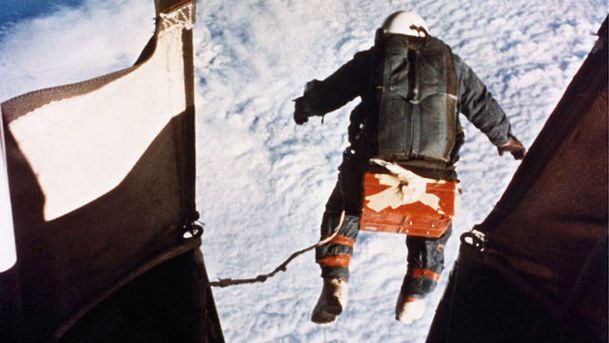Afternoon Play - The Man Who Jumped From Space

The real life story of Captain Joe Kittinger and Project Excelsior. As jet planes flew higher and faster in the 1950s, the USAF became increasingly worried about the safety of flight crew who had to eject at high altitude. So Project Excelsior was initiated to perfect a parachute system that would allow a safe, controlled descent after a high-altitude ejection. Joe Kittinger.....Simon Lee Phillips Beau.....David Fleeshman Stapp.....Garrick Hagon Bobby.....Kerry Shale Grubitz.....Andrew Westfield Technician.....Hamilton Berstock Producer Gary Brown Project Excelsior was initiated in 1958 to design a parachute system that would allow a safe, controlled descent after a high-altitude ejection. Francis Beaupre, a technician at Wright Field, Ohio (today Wright-Patterson Air Force Base), devised a multi-stage parachute system to facilitate manned tests. To test the parachute system, staff at Wright Field built a 200 ft (61 m) high helium balloon with a capacity of nearly 3 million cubic feet (85,000 m³) that could lift an open gondola and test pilot into the stratosphere. Joe Kittinger, who was test director for the project, made three ascents and test jumps. This is the story of the three jumps. The first test, Excelsior I, was made on November 16, 1959. Kittinger ascended in the gondola and jumped from an altitude of 23,300 m (76,400 ft).In this first test, the stabilizer parachute was deployed too soon, catching Kittinger around the neck and causing him to spin at 120 revolutions per minute. This caused Kittinger to lose consciousness, but his life was saved by his main parachute which opened automatically at a height of 3,000 m (10,000 ft). Despite this near-disaster on the first test, Kittinger went ahead with another test only three weeks later. The second test, Excelsior II, was made on December 11, 1959. This time, Kittinger jumped from an altitude of 22,800 m (74,700 ft) and descended in free-fall for 17,000 m (55,000 ft) before opening his main parachute.The third and final test, Excelsior III, was made on August 16, 1960. During the ascent, the pressure seal in Kittinger's right glove failed, and he began to experience severe pain in his right hand from the encroaching effects of frostbite. He decided not to inform the ground crew about this, in case they should decide to abort the test. Despite temporarily losing the use of his right hand, he continued with the ascent, climbing to an altitude of 31,333 m (102,800 ft). The ascent took one hour and 31 minutes and broke the previous manned balloon altitude record of 30,942 m (101,516 ft), which was set by Major David Simons as part of Project Man High in 1957. Kittinger stayed at peak altitude for 12 minutes, waiting for the balloon to drift over the landing target area. He then stepped out of the gondola to begin his descent. The small stabilizer parachute deployed successfully and Kittinger fell for 4 minutes and 36 seconds, setting a still-standing world record for the longest parachute free-fall.